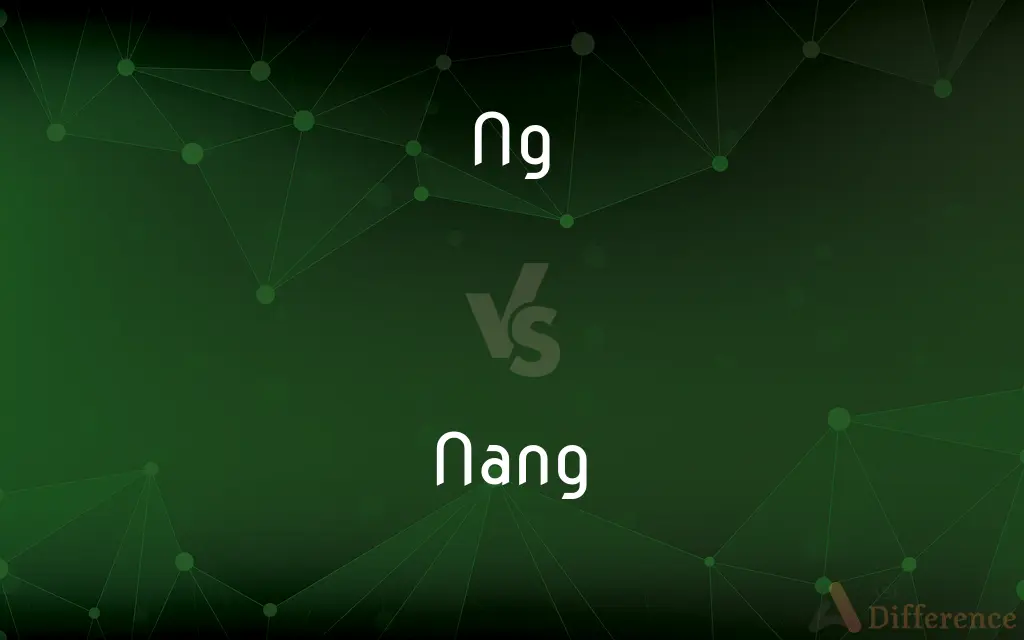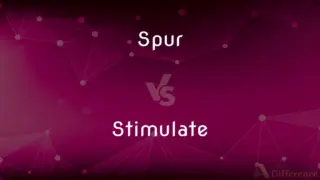Ng vs. Nang — What's the Difference?
Edited by Tayyaba Rehman — By Urooj Arif — Updated on April 16, 2024
"Ng" in Filipino serves as a marker for nouns or pronouns in certain grammatical roles, while "nang" links adverbs or phrases to verbs, or can substitute for "when" or "so that."

Difference Between Ng and Nang
Table of Contents
ADVERTISEMENT
Key Differences
"Ng" is used in Filipino to mark the object of a verb, indicating possession or acting as a connector in nominal phrases. Whereas "nang" is used to modify verbs, adjectives, or other adverbs, often translating to "when" or "how" in English.
"Ng" is equivalent to the English preposition "of," helping to denote ownership or composition, such as in "libro ng guro" (book of the teacher). On the other hand, "nang" can serve to intensify adjectives or adverbs, akin to "very" or "so" in English, as in "nang mabilis" (very fast).
In sentences, "ng" follows verbs and precedes the noun it affects, e.g., "Kumain ng mansanas" (ate an apple). Whereas "nang" connects clauses or provides adverbial detail, e.g., "Umuwi siya nang maaga" (He went home early).
"Ng" can also appear in serial noun constructions, showing relationships between multiple nouns without a verb intervening. Conversely, "nang" links sequential actions or states, emphasizing their connection or sequence.
In terms of pronunciation and stress, "ng" is typically unstressed in sentences, blending with the preceding or following words. In contrast, "nang" often carries stress, particularly when used to emphasize manner or time.
ADVERTISEMENT
Comparison Chart
Usage
Marks objects, possession
Modifies verbs, links clauses
Translation
Of, by
When, how, very, so
Position
Before nouns
Before verbs or clauses
Function
Connects nouns, shows possession
Shows manner, time, causality
Pronunciation
Usually unstressed
Often stressed
Compare with Definitions
Ng
Marks an object of action.
Kumain ng cake (Ate cake).
Nang
Used for hypotheticals.
Kung magtrabaho ka nang maigi (If you work hard).
Ng
Connects adjectives to nouns.
Punong puno ng bunga (Tree full of fruits).
Nang
Connects temporal clauses.
Umalis nang dumating siya (Left when he arrived).
Ng
Appears in idiomatic expressions.
May pera ng tao (The person has money).
Nang
Intensifies adjectives.
Malamig nang sobra (Very cold).
Ng
Functions in serial constructions.
Ang kwento ng bata ng bayan (The story of the child of the town).
Nang
Introduces a manner or degree.
Tumakbo nang mabilis (Ran very fast).
Ng
Indicates possession.
Bag ng estudyante (Student's bag).
Nang
Indicates causality.
Umuwi nang maaga para makapagpahinga (Went home early to rest).
Ng
(Internet) newsgroup
Nang
A metal bulb filled with nitrous oxide gas, inhaled for its disassociative effects, normally intended as a propellant for whipped cream.
Ng
One billionth (1/1,000,000,000) gram
Nang
Excellent; awesome; masterful; deeply satisfying.
That was well nang!
Common Curiosities
Can 'nang' and 'ng' be used interchangeably?
No, they serve different grammatical purposes.
What does 'ng' signify in a sentence?
It marks objects or possession.
Is there a pronunciation difference between 'ng' and 'nang'?
Yes, 'ng' is usually unstressed, while 'nang' is often stressed.
How is 'nang' used differently from 'ng'?
It modifies verbs or links clauses, unlike 'ng' which connects nouns.
What is an example of 'ng' indicating ownership?
Bag ng estudyante (Student's bag).
When should 'nang' be used in a sentence?
When linking actions or describing manners or times.
What is an example of 'ng' in a serial noun construction?
Ang kwento ng bata ng bayan.
Can 'ng' function independently in a sentence?
It usually appears with other words to form a meaningful phrase.
How does 'nang' link clauses?
By connecting actions or temporal sequences.
What is a typical use of 'ng' in Filipino?
To connect nouns in a phrase, e.g., Bag ng estudyante.
How does 'nang' modify an adjective?
It can intensify it, e.g., Malamig nang sobra (Very cold).
Does 'nang' have any synonyms in Filipino?
It can be synonymous with 'kapag' (when) or 'para' (so that) in certain contexts.
Is 'nang' used for emphasis in Filipino?
Yes, particularly to emphasize the manner or intensity of an action.
Can 'ng' ever appear at the start of a sentence?
Typically, no; it follows verbs or nouns.
Share Your Discovery

Previous Comparison
Spur vs. Stimulate
Next Comparison
Potential vs. AbilityAuthor Spotlight
Written by
Urooj ArifUrooj is a skilled content writer at Ask Difference, known for her exceptional ability to simplify complex topics into engaging and informative content. With a passion for research and a flair for clear, concise writing, she consistently delivers articles that resonate with our diverse audience.
Edited by
Tayyaba RehmanTayyaba Rehman is a distinguished writer, currently serving as a primary contributor to askdifference.com. As a researcher in semantics and etymology, Tayyaba's passion for the complexity of languages and their distinctions has found a perfect home on the platform. Tayyaba delves into the intricacies of language, distinguishing between commonly confused words and phrases, thereby providing clarity for readers worldwide.














































